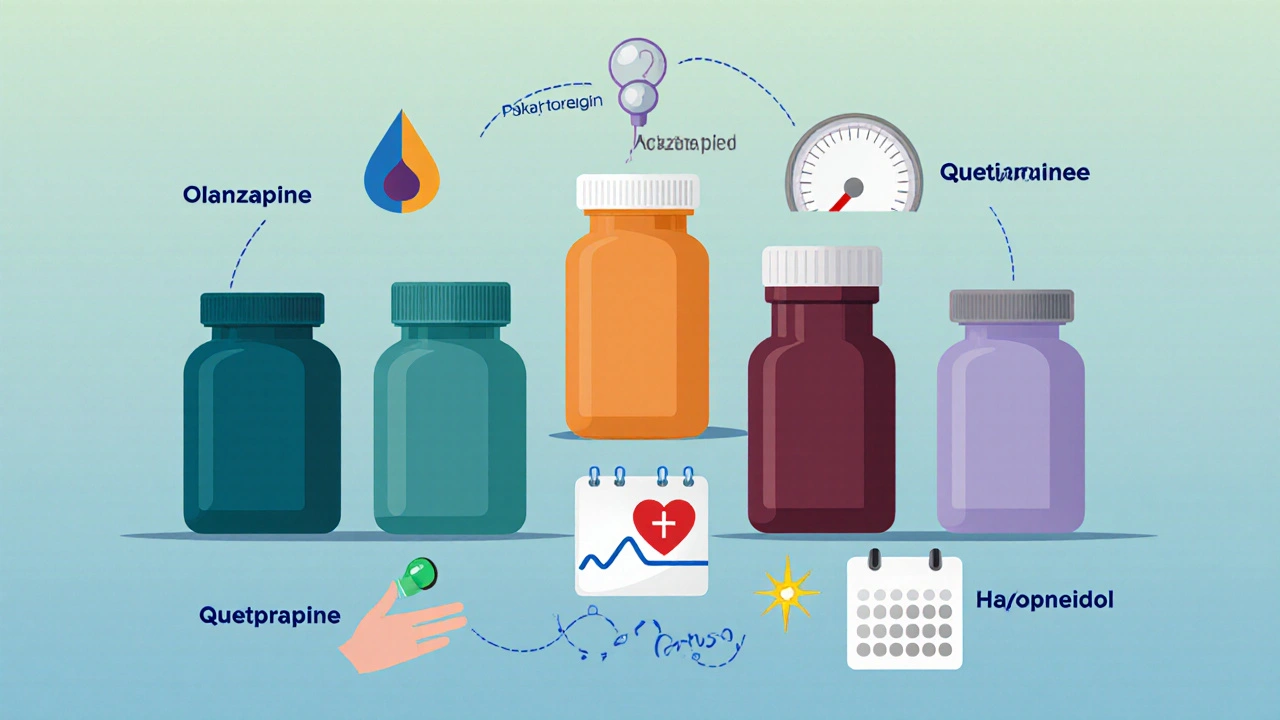
Antipsychotic Comparison Tool
Olanzapine (Zyprexa)
Typical Daily Dose: 5-20 mg
Weight-Gain Risk: High
Metabolic Impact: Significant (↑ glucose, lipids)
EPS Frequency: Low-Moderate
Special Monitoring: Baseline labs, periodic weight/BMI
Select Alternative
When a doctor prescribes Olanzapine for schizophrenia or bipolar disorder, patients often wonder if there’s a better fit-maybe a drug with fewer side effects or a simpler dosing schedule. This guide breaks down how Zyprexa (Olanzapine) stacks up against the most common alternatives, so you can talk with your clinician confidently.
Key Takeaways
- Zyprexa is highly effective for acute psychosis but carries a strong risk of weight gain and metabolic issues.
- Risperidone and Aripiprazole are popular first‑line choices when weight is a concern.
- Quetiapine offers sedation benefits for patients with insomnia but may cause low blood pressure.
- Clozapine remains the gold standard for treatment‑resistant schizophrenia, despite needing regular blood monitoring.
- Choosing the right drug depends on efficacy, side‑effect profile, dosing convenience, and personal health factors.
What Is Zyprexa (Olanzapine)?
Olanzapine is a second‑generation antipsychotic, also known as Zyprexa. It works by blocking dopamine D2 and serotonin 5‑HT2A receptors, helping to calm hallucinations and mood swings. First approved by the FDA in 1996, Olanzapine is available in tablets, orally disintegrating tablets, and a long‑acting injectable form.
How Olanzapine Works
The drug’s dual dopamine‑serotonin blockade reduces the overstimulation that leads to psychotic symptoms. By moderating these pathways, patients often see rapid improvement in thought disorder, delusions, and manic episodes. However, the same receptor activity also influences appetite regulation, which explains the notorious weight‑gain side effect.
Primary Uses
Olanzapine is FDA‑approved for:
- Schizophrenia
- Bipolar I disorder (manic or mixed episodes)
- Maintenance treatment of bipolar disorder
- Adjunct therapy for major depressive disorder (when combined with fluoxetine)

Side‑Effect Profile
While many patients tolerate Olanzapine well, clinicians keep a close eye on:
- Weight gain: Average increase of 4‑10kg in the first six months.
- Metabolic syndrome: elevated fasting glucose and triglycerides.
- Sedation and drowsiness, especially at higher doses.
- Extrapyramidal symptoms (EPS) are less common than with older antipsychotics but can still occur.
- Elevated prolactin levels in some individuals.
Top Alternatives to Olanzapine
Below are the most frequently considered substitutes, each marked up for easy knowledge‑graph extraction.
Risperidone
Risperidone is a second‑generation antipsychotic that offers strong dopamine blockade with a lower propensity for weight gain. Typical starting dose is 1mg daily, titrated to 4‑6mg for schizophrenia. It’s praised for its relatively flat metabolic profile, though it can cause higher rates of EPS at doses above 6mg.
Quetiapine
Quetiapine (Seroquel) is known for its sedating effect, making it useful when insomnia co‑occurs with psychosis. Doses range from 150‑800mg daily. While weight gain is moderate, orthostatic hypotension can be an issue, especially when standing up quickly.
Aripiprazole
Aripiprazole works as a dopamine partial agonist, which often translates to less sedation and minimal weight gain. Starting at 10‑15mg daily, it can be increased to 30mg. Some patients report activation (feeling jittery), but metabolic side effects are among the lowest in its class.
Clozapine
Clozapine is reserved for treatment‑resistant schizophrenia because of its superior efficacy. Doses begin at 12.5mg twice daily, targeting 300‑600mg. The trade‑off is a mandatory weekly blood test to monitor for agranulocytosis, plus a higher risk of seizures and myocarditis.
Haloperidol
Haloperidol is a first‑generation (typical) antipsychotic, valued for its potent dopamine D2 antagonism. It’s often used in acute agitation at doses of 5‑20mg daily. Weight gain is minimal, but EPS and tardive dyskinesia are common concerns.
Side‑by‑Side Comparison
| Drug | Typical Daily Dose | Weight‑Gain Risk | Metabolic Impact | EPS Frequency | Special Monitoring |
|---|---|---|---|---|---|
| Olanzapine | 5‑20mg | High | Significant (↑ glucose, lipids) | Low‑Moderate | Baseline labs, periodic weight/BMI |
| Risperidone | 1‑6mg | Low‑Moderate | Modest | Moderate (dose‑dependent) | Prolactin if >6mg |
| Quetiapine | 150‑800mg | Moderate | Moderate | Low | Monitor blood pressure |
| Aripiprazole | 10‑30mg | Low | Minimal | Low | Watch for activation |
| Clozapine | 300‑600mg | Moderate‑High | High (requires fasting glucose) | Low | Weekly ANC counts |
| Haloperidol | 5‑20mg | Low | Minimal | High (tremor, rigidity) | EPS rating scales |
How to Choose the Right Antipsychotic
Think of medication selection as a balancing act between three main factors:
- Efficacy for your specific symptoms. Some drugs calm agitation faster; others excel at preventing relapse.
- Side‑effect tolerance. If you’re already managing diabetes, a drug with low metabolic impact (like Aripiprazole) may be wiser.
- Practical considerations. Daily pill versus long‑acting injection, need for blood tests, cost, and insurance coverage all play a role.
Discuss each point with your psychiatrist. Bring a list of any existing health conditions, current meds, and lifestyle factors. That way, the clinician can match the drug profile to your personal context.
Frequently Asked Questions
Can I switch from Olanzapine to another antipsychotic safely?
Yes, but the transition should be supervised. Doctors usually taper Olanzapine while introducing the new drug to avoid withdrawal or symptom rebound. A cross‑taper over two to three weeks is common.
Why does Olanzapine cause so much weight gain?
Olanzapine blocks histamine H1 receptors and serotonin 5‑HT2C receptors, both of which regulate appetite. The blockage increases hunger and reduces satiety, leading to calorie over‑consumption.
Is the long‑acting injectable form of Olanzapine better than the oral tablet?
Injectable Olanzapine (every 2‑4 weeks) can improve adherence for patients who miss daily doses. However, it shares the same side‑effect profile, and injection site reactions can occur.
What should I monitor while taking Olanzapine?
Track weight, fasting glucose, lipid panel, and blood pressure every 3‑6 months. Report any sudden drowsiness, muscle stiffness, or unusual mood changes to your provider.
Are there any non‑pharmacological options that work with these meds?
Cognitive‑behavioral therapy, family education, and regular exercise can boost medication effectiveness and help manage side effects like weight gain.

Next Steps
If you’re currently on Olanzapine and uneasy about side effects, start by scheduling a medication review. Bring recent lab results, a list of all prescriptions, and any concerns about weight or energy levels. Your psychiatrist can then propose a tailored switch-perhaps to Aripiprazole for metabolic safety or to Clozapine if symptoms remain uncontrolled.
Remember, no single drug works for everyone. The best choice balances symptom control with quality of life. Armed with this comparison, you can have a clearer conversation and move toward a treatment plan that feels right for you.
15 Comments
Amanda Turnbo
October 4, 2025 At 16:18While the table nails down the basics, anyone with a modicum of clinical sense knows that Olanzapine’s “high” weight‑gain risk isn’t just a footnote-it’s often the deal‑breaker for patients. Still, the drug’s efficacy in acute psychosis keeps it perched near the top of many formularies.
Jenn Zuccolo
October 7, 2025 At 19:18In the grand tapestry of psychopharmacology, each antipsychotic threads its own hue of benefit and burden. Olanzapine paints a vivid canvas of symptom control, yet its metabolic brushstrokes can blur the picture of long‑term health. By contrast, a drug like Aripiprazole offers a subtler palette, preserving weight while still quelling delusions. Thus, the choice becomes a philosophical balance between immediacy and sustainability.
Courtney The Explorer
October 10, 2025 At 22:18From a neuro‑psychiatric systems engineering perspective, the pharmacokinetic profile of olanzapine-binding potency at D2 and 5‑HT2A receptors-propels rapid amelioration of positive symptoms; however, concomitant antagonism of H1 and 5‑HT2C receptors precipitates hyperphagic cascades-metabolic dysregulation ensues. Consequently-clinical stewardship mandates vigilant monitoring of anthropometric indices and glycemic markers.
Ashleigh Connell
October 14, 2025 At 01:18Honestly, the side‑effect chart reads like a colorful menu-you’ve got the heavy‑calorie option with Olanzapine, the light‑bites of Aripiprazole, and the spicy mix of Quetiapine. It’s all about what flavors you can tolerate without feeling sick. Pick the dish that fits your palate and lifestyle, and don’t forget to sprinkle in some exercise.
Erin Knight
October 17, 2025 At 04:18One must applaud the author’s attempt at a comparative matrix, yet the analysis borders on the superficial, neglecting nuanced pharmacogenomic considerations that truly differentiate these agents. A deeper dive would elevate this piece from pedestrian to scholarly.
Kavita Jadhav
October 20, 2025 At 07:18I hear you on the weight‑gain worries-many patients feel trapped by those extra pounds. Incorporating a balanced diet and regular walks can offset some of Olanzapine’s metabolic side effects. Talking openly with your prescriber about switching to a metabolically gentler option is always worthwhile.
Tony Halstead
October 23, 2025 At 10:18Choosing the right antipsychotic is akin to planning a long journey across varied terrain; each medication offers its own set of roads, detours, and occasional roadblocks. Olanzapine, for instance, provides a smooth highway of rapid symptom relief, yet the toll booths of weight gain and elevated glucose often demand frequent stops for monitoring. In contrast, Aripiprazole resembles a scenic route with fewer scenic tolls, delivering modest efficacy while preserving metabolic health for many travelers. Risperidone sits somewhere between these extremes, offering a balanced blend of effectiveness and manageable side effects, though its propensity for prolactin elevation can be a hidden pothole for some. Quetiapine, with its sedative qualities, can be likened to a rest stop that helps patients catch some much‑needed sleep, but one must watch for orthostatic drops that could cause a stumble. Clozapine, reserved for the most refractory cases, is the rugged off‑road vehicle that can conquer the toughest peaks but requires weekly blood tests, akin to regular car inspections, to ensure the engine remains safe. Haloperidol, the classic model, delivers strong dopamine blockade akin to a powerful tractor, yet its high EPS risk resembles a noisy, rattling ride that many prefer to avoid. The decision matrix should also factor in a patient’s comorbidities-diabetes, cardiovascular disease, or a history of movement disorders act as weather conditions influencing route selection. Cost and insurance coverage act as fuel availability; a drug that seems perfect on paper may be out of reach if the budget runs dry. Moreover, patient preferences, such as willingness to attend regular labs or tolerate sedation, shape the final itinerary. Shared decision‑making, therefore, becomes the navigation system that integrates clinical data, lifestyle considerations, and personal values. Regular follow‑ups serve as roadside checks, ensuring the chosen path remains optimal and adjustments can be made promptly. Ultimately, the goal is not merely reaching symptom remission but arriving at a destination where quality of life thrives alongside clinical stability. By weighing efficacy against side‑effect profiles, and aligning treatment with individual circumstances, clinicians and patients can chart a course that feels both safe and satisfactory.
leo dwi putra
October 26, 2025 At 13:18Whoa, this whole discussion feels like a drama series-Olanzapine swoops in as the charismatic hero, then Haloperidol shows up like the grizzled anti‑hero with a bad attitude. The plot twists are real, folks.
Krista Evans
October 29, 2025 At 16:18Hey, if you’re feeling the weight creep, try pairing your meds with a quick 15‑minute walk each day-small steps add up! You’ve got this, keep pushing forward.
Mike Gilmer2
November 1, 2025 At 19:18What a rollercoaster of drug choices-one minute you’re on a high‑dose thrill ride, the next you’re stuck in a slow‑motion drama. Hold on tight.
Alexia Rozendo
November 4, 2025 At 22:18Sure, everyone loves a fancy chart, but let’s be real-if you’re not checking your blood sugar, the whole comparison is just pretty wallpaper.
Kimberly Newell
November 8, 2025 At 01:18Yo, ths post is gud but kinda long, lol. Maybe add a quick cheat sheet at the end so us normal peeps can grab the gist.
Drew Burgy
November 11, 2025 At 04:18Ever notice how pharma companies push Olanzapine like the “miracle cure” while hiding the hidden agenda of profit? Of course they do-big pharma runs the show, and we’re just the pawns in their game. Stay woke, folks.
Jacob Hamblin
November 14, 2025 At 07:18Appreciate the thorough breakdown; it’ll help me discuss options with my doctor. Thanks for the clear summary.
Andrea Mathias
November 17, 2025 At 10:18Honestly, the whole “choose a drug” spiel feels like a patriotic rally-just pick the one that makes America great again, regardless of individual health. Such nationalistic fluff.

Post A Comment